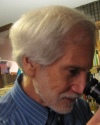
|
Degrees:
Ph.D., Harvard University
M.S., Michigan State Univ
B.S., Michigan State Univ.
Mark P. Silverman joined the Trinity physics faculty in 1982. A principal part of his scientific interests involves the investigation of uniquely quantum processes (interference, entanglement) and the examination of various nuclear decay processes (alpha, beta, electron capture) for evidence of violations of currently known physical laws. Another facet of his experimental research concerns the scattering of light from media with unusual optical properties. One outcome of these experiments is the development of a polarimetric method for imaging objects embedded in visually opaque media. Among his theoretical interests is the investigation of the final equilibrium states of stars that have exhausted their nuclear fuel and have collapsed to compact objects of enormous density. Besides formal studies of a scholarly nature, Dr. Silverman enjoys just "messing around" and has investigated the uncommon behavior of common things such as physics devices (Vortex Tube, "Voice of the Dragon" tube, "World's Simplest Motor"), twirled keychains, exploding glass (Prince Rupert's drops) and all kinds of optical, thermal, and fluid phenomena observable in one's kitchen.
In addition to teaching all the courses of a traditional physics curriculum, he has created and taught special-interest courses like "Cosmic Evolution and the Search for Life in the Universe," "Role of Controversy in Science," and "Power for the People: the Insatiable Quest for Energy."
Dr. Silverman was the first occidental professor invited to be Visiting Chief Researcher at the Hitachi Advanced Research Laboratory (Tokyo) and has held a number of other distinguished positions such as the Joliot Chair of Physics at the Ecole Superieure de Physique et Chimie Industrielles (Paris) and the George A Jarvis Chair of Physics at Trinity College. |
-
Classical Dynamics
-
Statistical and Thermal Physics
-
Applications of Quantum Physics
-
Modern Physics (study of light, Einstein's theory of special relativity, and concepts in quantum physics)
-
Special Topics on Energy such as: Power for the People: The Insatiable Quest for Energy and Its Consequences
-
Special Topics on Nature of Science such as: The Philosophical Role of Controversy in Science
|
-
Solar Energy Diffusion and Local Climate Change
-
Nuclear Decay
-
Quantum Interference & Entanglement
-
Internal Structure of Highly Compact Stars
-
Light Scattering in Chiral Media
-
Stochastic Processes and Information
-
Development of Instructional Methods That Motivate Self-Directed Learning
|
Articles:
- Silverman, M P, “Reaction Forces on a Fixed Ladder in Static Equilibrium: Analysis and Definitive Experimental Test of the Ladder Problem”, World Journal of Mechanics 8 (2018) 311-342.
- Silverman, M P and Farrah, J, “Bending of a Tapered Rod: Modern Application and Experimental Test of Elastica Theory”, World Journal of Mechanics 8 (2018) 272-300.
- Silverman, M P and Mudvari, A, “Brownian Motion of Radioactive Particles: Derivation and Monte Carlo Test of Spatial and Temporal Distributions”, World Journal of Nuclear Science and Technology 8 (2018) 86-119.
- Silverman, M P, “Brownian Motion of Decaying Particles: Transition Probability, Computer Simulation, and First-Passage Times”, Journal of Modern Physics 8 (2017) 1809-1849.
- Silverman, M P, “Analysis of Residence Time in the Measurement of Radon Activity by Passive Diffusion in an Open Volume: A Micro-Statistical Approach”, World Journal of Nuclear Science and Technology 7 (2017) 252-273.
- Silverman, M P, "Scientific Controversies: Authentic and Contrived", Science & Education 26
- Silverman, M P, "Method to Measure Radon Concentration in an Open Volume with Geiger-Mueller Counters: Analysis from First Principles", World Journal of Nuclear Science and Technology 6 (2016) 232-260.
- Silverman, M P, "Search for Anomalies in the Decay of Radioactive Mn-54", Europhysics Letters 114 (2016) 62001 (1-6).
- Silverman, M P, "Search for Non-Standard Radioactive Decay Based on Distribution of Activities", Europhysics Letters 110 (2015) 52001 1-5.
- Silverman, M P, "Motivating Students to Learn Science: A Physicist's Perspective", Creative Education 6 (2015) 1982-1992.
- Silverman, M P, "Cheating or Coincidence? Statistical Method Employing the Principle of Maximum Entropy for Judging Whether a Student Has Committed Plagiarism", Open Journal of Statistics 5 (2015) 143-157.
- Silverman, M P, "Statistical Analysis of Subsurface Diffusion of Solar Energy with Implications for Urban Heat Stress", Journal of Modern Physics 5 (2014) 751-762.
- Silverman, M P, "Theory of Nuclear Half-Life Determination by Statistical Sampling", Europhysics Letters 105 (2014) 22001 1-5.
- Silverman, M P, "Numerical Procedures for Calculating the Probabilities of Recurrent Runs", Open Journal of Statistics 4 (2014) 122-131.
- Silverman, M P et al. "Quantum Stabilization of General-Relativistic Variable-Density Stars", Journal of Modern Physics 3 (2012) 561-569.
- Silverman, M P, Strange, W, Bower, J, and Ikejimba, L, "Fragmentation of Explosively Metastable Glass", Physica Scripta 85 (2012) 065403 (1-9).
- Silverman, M P and Strange, W, "Search for Correlated Fluctuations in the Decay of Na-22", Europhysics Letters 87 (2009): 32001 1-6.
Books:
- Silverman, Mark P. A Certain Uncertainty: Nature’s Random Ways. Cambridge: Cambridge University Press, 2014.
- Silverman, Mark P. Quantum Superposition: Counterintuitive Consequences of Coherence, Entanglement and Interference. New York: Springer, 2008.
- Silverman, Mark P. A Universe of Atoms, An Atom in the Universe. New York: Springer, 2002.
- Silverman, Mark P. Probing The Atom: Interactions of Coupled States, Fast Beams, and Loose Electrons. Princeton, NJ: Princeton Univ. Press, 2000.
- Silverman, Mark P. Waves and Grains: Reflections on Light and Learning. Princeton, NJ: Princeton Univ. Press, 1998.
- Silverman, Mark P. More Than One Mystery: Explorations in Quantum Interference. New York: Springer, 1995.
- Silverman, Mark P. And Yet It Moves: Strange Systems and Subtle Questions in Physics. Cambridge: Cambridge Univ. Press, 1993, Second Edition 2015.
|
|
|